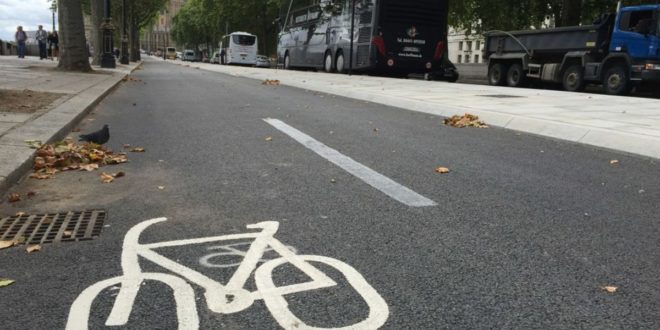Something that is “egregious” is outstandingly bad. It’s therefore a surprising epithet for the architect of the National Cycling Strategy to use for a protected cycleway. But that is how former transport minister Steven Norris has described London’s Embankment Cycle Superhighway. In a series of tweets, Norris claimed some cycleways were “paralysing other traffic” and that the Embankment cycleway has made a 12 minute [car] journey into one that now lasts more than 45 minutes.
This is an increasingly common claim from cabbies, shock-jocks and some MPs, who often go on to claim that, to create the Embankment cycleway, roadspace was taken away from motor traffic. In fact, a simple look back at the Embankment on Google Streetview shows that its kerb-protected cycleway did not grub up a road but was previously an extended linear parking space for tourist coaches.
Norris is not your common or garden former transport minister – he has impeccable cycling credentials. He kick-started the Tory government’s National Cycling Strategy of 1996 and later, once out of power, became the first chair of the National Cycling Strategy Board which was charged with implementing the strategy.
Today, Norris is chairman of Soho Estates which controls around 60 acres of London’s Soho. He is also a fellow of the Chartered Institute of Highways and Transportation, a commissioner of the Independent Transport Commission, and chair of the Council of the National Infrastructure Planning Association.
“Getting the balance right between promoting safe cycling while not paralysing other traffic [should] be the aim,” Norris tweeted. “[Transport for London] forgot that.”
And Norris would know for he was a member of the board of Transport for London under Mayor Boris Johnson and was therefore part of the administration which planned and built the first protected Cycle Superhighways, including the flagship one beside the Thames and leading up to the Houses of Parliament via the Embankment.
“It’s so sad that some of the recent stuff (Embankment the most egregious example) was so badly planned and executed,” wrote Norris.
“I authored the first National Cycle Strategy. I’m thrilled that cycling has grown as it has done. I pushed it further with Ken and Boris. Most of the CSH is great. But the Embankment is simply badly planned and executed.”
Norris’ original tweet was regarding last week’s interview of commissioner for Transport for London Mike Brown by Nick Ferrari of LBC, one of cycling’s fiercest critics. Brown told Ferrari: “I apologise absolutely for the way cycle lanes were delivered in the last mayor’s administration.
“I think it was ill-judged, it was too fast and ill thought through in the speed in which it was done, which I’m afraid is the main downside of living in a democracy – people want to do things in their term.”
This was leapt upon by Ferrari who, like former chancellor of the exchequer Lord Lawson, has claimed, bizarrely, that the capital’s cycleways have caused as nearly as much damage to London as the Luftwaffe during the Blitz in the Second World War.
“Well said Mike Brown,” tweeted Norris.
“Wonderful to see how many more people cycle now compared to 20 yrs ago. But badly planned & dangerous cycle way benefits no one. Embankment the most egregious example but there are others.”
He also claimed that the Embankment cycleway was little used: “Virtually no use during most of the day.”
Statistics from Transport for London show otherwise, and so do videos and photographs. Cycle advocates point out that while roads can often appear full that’s because of vehicle size – one person in a motor vehicle takes up a great deal of space while cyclists are very space efficient. What looks like an empty cycleway can often be a route that has merely cleared quickly. New counters on some cycleways in London show that usage is very high – with 1000 people on bikes passing by the counters in just half an hour.
Norris appears to be in favour of peak-time-only cycleways because he re-tweeted a poster who suggested this as a solution. Norris also seemed to suggest that, as many others have done without producing any evidence, that it’s not motorists causing air pollution but cyclists on cycleways. “Standing pollution??” pondered Norris.
With friends like these …
 BikeBiz Bicycle and cycling retail news
BikeBiz Bicycle and cycling retail news




